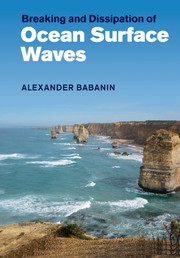Book contents
- Frontmatter
- Contents
- Preface
- 1 Introduction
- 2 Definitions for wave breaking
- 3 Detection and measurement of wave breaking
- 4 Fully nonlinear analytical theories for surface waves and numerical simulations of wave breaking
- 5 Wave-breaking probability
- 6 Wave-breaking severity
- 7 Energy dissipation across the wave spectrum
- 8 Non-dissipative effects of breaking on the wave field
- 9 Role of wave breaking in the air–sea interaction
- 10 Conclusions. What else do we need to know about wave breaking?
- References
- Index
2 - Definitions for wave breaking
Published online by Cambridge University Press: 25 October 2011
- Frontmatter
- Contents
- Preface
- 1 Introduction
- 2 Definitions for wave breaking
- 3 Detection and measurement of wave breaking
- 4 Fully nonlinear analytical theories for surface waves and numerical simulations of wave breaking
- 5 Wave-breaking probability
- 6 Wave-breaking severity
- 7 Energy dissipation across the wave spectrum
- 8 Non-dissipative effects of breaking on the wave field
- 9 Role of wave breaking in the air–sea interaction
- 10 Conclusions. What else do we need to know about wave breaking?
- References
- Index
Summary
Following the intuitively familiar concept of wave breaking discussed in Section 1.2, a variety of phenomenological definitions can be formulated. Wikipedia suggests such a definition, applicable across the range of wave processes, including water waves as well as electromagnetic waves, waves in plasmas and in other physical media:
“In physics, a breaking wave is a wave whose amplitude reaches a critical level at which some process can suddenly start to occur that causes large amounts of wave energy to be dissipated. At this point, simple physical models describing the dynamics of the wave will often become invalid, particularly those which assume linear behavior” (http://en.wikipedia.org/wiki/Wave_breaking).
The Glossary of Meteorology of the American Meteorological Society defines the breaking of ocean surface waves more specifically:
“A complex phenomenon in which the surface of the wave folds or rolls over and intersects itself. In the process it may mix (entrain) air into the water and generate turbulence. The causes of wave breaking are various, for example, through the wave steepening as it approaches a beach, through an interaction with other waves in deep water, or through the input of energy from the wind causing the wave to steepen and become unstable” (http://amsglossary.allenpress.com/glossary/browse? s = w&p = 11).
As discussed above, a more explicit physical, yet only mathematical definition of the wave-breaking phenomenon is hardly possible.
- Type
- Chapter
- Information
- Breaking and Dissipation of Ocean Surface Waves , pp. 12 - 48Publisher: Cambridge University PressPrint publication year: 2011



